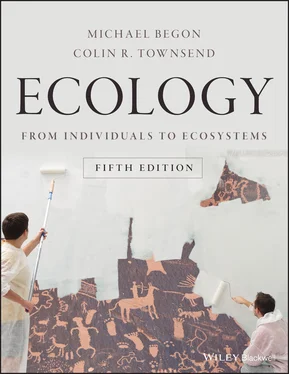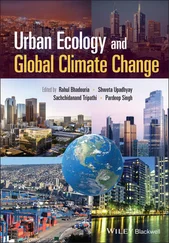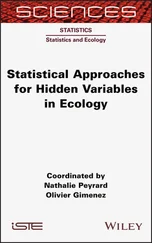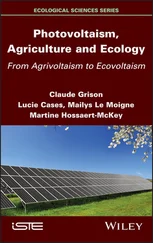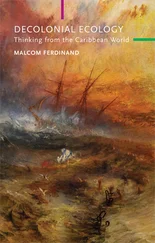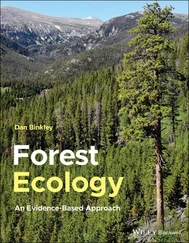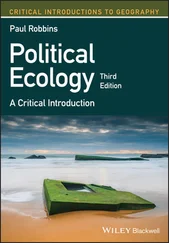specialists and generalists
An important distinction amongst animal consumers is whether they are specialised or generalised in their diet. Generalists ( polyphagous species) take a wide variety of prey species, though they very often have clear preferences and a rank order of what they will choose when there are alternatives available. Some specialists consume only particular parts of their prey though they range over a number of species. This is most common among herbivores because, as we saw in Figure 3.26and shall see again in Figure 3.29, different parts of plants are quite different in their composition. Thus, many birds specialise in eating seeds though they are seldom restricted to a particular species. Other specialists, however, may feed on only a narrow range of closely related species or even just a single species (when they are said to be monophagous ). Examples are caterpillars of the cinnabar moth (which eat the leaves, flower buds and very young stems of species of ragwort, Senecio ) and many species of host‐specific parasites.
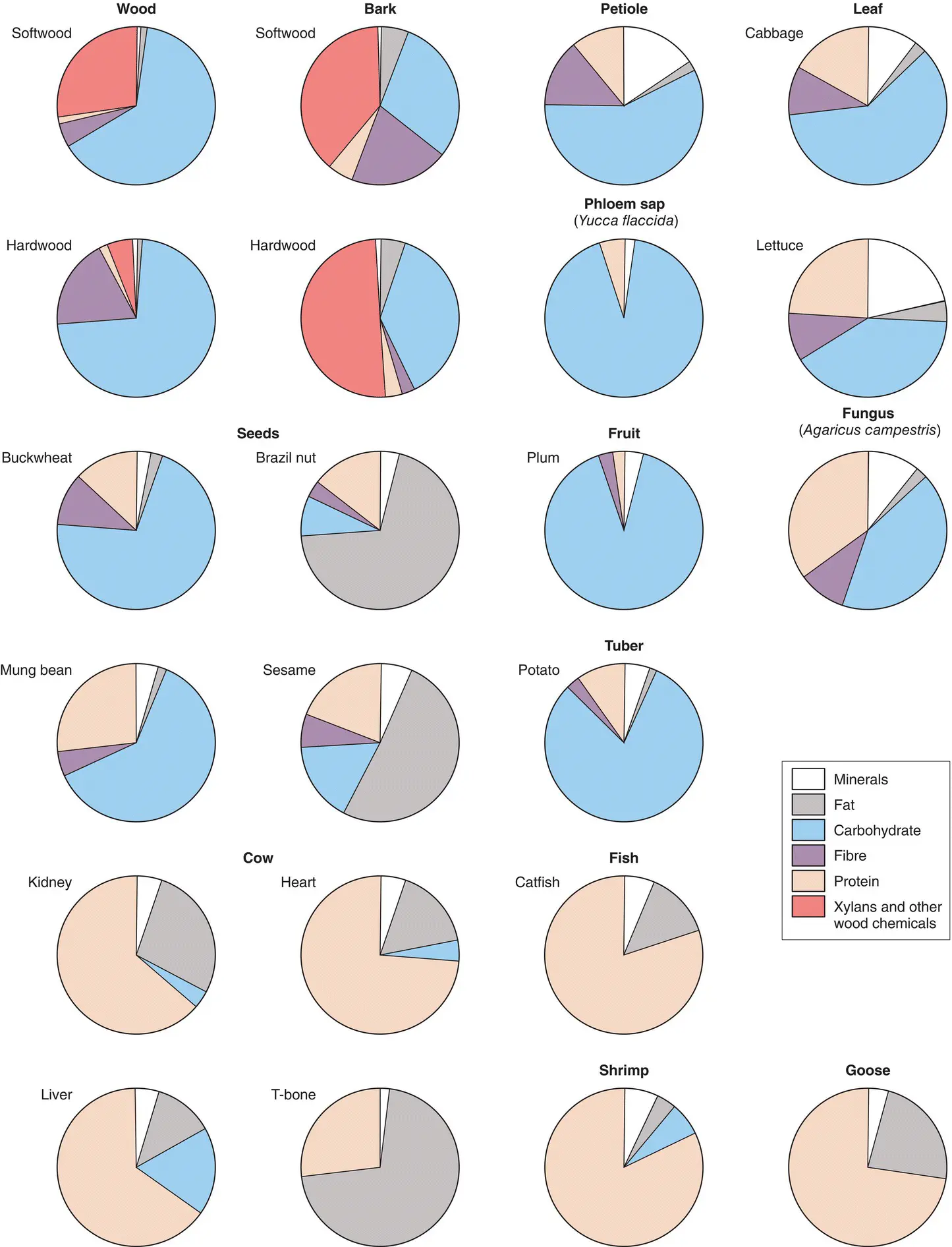
Figure 3.29 The composition of various plant parts and of the bodies of animals that serve as food resources for other organisms.
Data from various sources.
the importance of lifespan
Many of the resource‐use patterns found among animals reflect the different lifespans of the consumer and what it consumes. Individuals of long‐lived species are likely to be generalists: they cannot depend on one food resource being available throughout their life. Specialisation is increasingly likely if a consumer has a short lifespan. Evolutionary forces can then shape the timing of the consumer’s food demands to match the timetable of its prey. Specialisation also allows the evolution of structures that make it possible to deal very efficiently with particular resources. This is especially the case with mouthparts. Darwin’s hawkmoth, Xanthopan morganii praedicta , with its 20 cm long proboscis, is alone in being able to take nectar and pollen from the Madagascan orchid, Angraecum sesquipidale , with its near‐30 cm long nectary. (It is called Darwin’s hawkmoth, because Charles Darwin predicted its existence on seeing the flower 20 years before the moth itself was discovered.) This can be interpreted as an exquisite product of the evolutionary process that has given the moth access to a valuable food resource – or as an example of the ever‐deepening rut of specialisation that has constrained what the moth can feed on. The more specialised the food resource required by an organism, the more it is constrained to live in patches of that resource or to spend time and energy in searching for it among a mixture of resources. This is one of the costs of specialisation. We return to food preferences and diet widths in Section 9.2.
3.7.1 The nutritional contents of plants and animals and their extraction
C : N ratios in animals and plants
As a ‘package’ of resources, the body of a green plant is quite different from the body of an animal. This has a marked effect on the value of these resources as potential food ( Figure 3.29). The most important contrast is that plant cells are bounded by walls of cellulose, lignin and/or other structural materials. It is these cell walls that give plant material its high fibre content. The presence of cell walls is also largely responsible for the high fixed carbon content of plant tissues and the high ratio of carbon to other important elements. For example, the carbon : nitrogen (C : N) ratio of plant tissues commonly exceeds 40 : 1.
In contrast, the C : N ratios in bacteria, fungi and animals are approximately 10 : 1. When plant parts are decomposed, the microbes multiplying on the decaying plant withdraw nitrogen and other mineral resources from their surroundings and build them into their own microbial bodies. Thus, plant material with a high carbon content is converted to microbial bodies with a relatively low carbon content. For this reason, and because microbial tissue is more readily digested and assimilated, plant detritus that has been richly colonised by microorganisms is generally preferred by detritivorous animals. Unlike plants, animal tissues contain no structural carbohydrate or fibre component but are rich in fat and, in particular, protein.
different plant parts represent very different resources …
The various parts of a plant, however, have very different compositions ( Figure 3.29) and so offer quite different resources. Bark, for example, is largely composed of dead cells with corky and lignified walls and is quite useless as a food for most herbivores (even species of ‘bark beetle’ specialise on the nutritious cambium layer just beneath the bark, rather than on the bark itself). The richest concentrations of plant proteins (and hence of nitrogen) are in the meristems in the buds at shoot apices and in leaf axils. Not surprisingly, these are usually heavily protected with bud scales and defended from herbivores by thorns and spines. Seeds are usually dried, packaged reserves rich in starch or oils as well as specialised storage proteins. And the very sugary and fleshy fruits are resources provided by the plant as 'payment' to the animals that disperse the seeds. Very little of the plants’ nitrogen is spent on these rewards.
The dietary value of different tissues and organs is so different that it is no surprise to find that most small herbivores are specialists – not only on particular species or plant groups, but on particular plant parts: meristems, leaves, roots, stems, etc. The smaller the herbivore, the finer is the scale of heterogeneity of the plant on which it may specialise. Extreme examples can be found in the larvae of various species of oak gall wasps, some of which may specialise on young leaves, some on old leaves, some on vegetative buds, some on male flowers and others on root tissues.
… but the composition of all herbivores is remarkably similar
By contrast, the composition of the bodies of different herbivores is remarkably similar. In terms of the content of protein, carbohydrate, fat, water and minerals per gram, there is very little to choose between a diet of caterpillars, cod or venison. The packages may be differently parcelled (and the taste may be different), but the contents are essentially the same. Carnivores, then, are not faced with problems of digestion (and they vary rather little in their digestive apparatus), but rather with difficulties in finding, catching and handling their prey (see Chapter 9).
Differences in detail aside, herbivores that consume living plant material – and saprotrophs that consume dead plant material – all utilise a food resource that is rich in carbon and poor in protein. Hence, the transition from plant to consumer involves a massive burning off of carbon as the C : N ratio is lowered. The main waste products of organisms that consume plants are carbon‐rich compounds: CO 2, fibre, and in the case of aphids, for example, carbon‐rich honeydew dripping from infested trees. By contrast, the greater part of the energy requirements of carnivores is obtained from the protein and fats of their prey, and their main excretory products are in consequence nitrogenous. The crucial role of gut microbes in digestion for all animals, but for herbivores especially, is discussed in Section 13.6.
ecological stoichiometry
These ratios in the composition of organisms, and the changes in these ratios from one trophic level to the next, are the realm of ecological stoichiometry (Hessen et al ., 2013), defined as ‘The balance of multiple chemical substances in ecological interactions and processes, or the study of this balance’ (Sterner & Elser, 2002) – see also Sections 11.2.5and 20.4.3. The approach can be traced back to what is commonly called Liebig’s ‘law of the minimum’ (Liebig, 1840), which states that organismal growth rates are limited by whichever element has the lowest rate of environmental supply relative to the organisms’ demands. A more direct connection still can be traced to the work of Alfred C. Redfield going back to the 1930s, focusing especially on the apparent constancy of the ratio of nitrate to phosphate (around 16 : 1) in the biomass of phytoplankton and in seawater (Gruber & Deutsch, 2013). Indeed, ecological stoichiometry has always been most influential in aquatic, especially marine biogeochemistry, where the focus is usually on nitrogen, phosphorus and carbon, though other elements, for example iron, also have key roles to play (Tagliabue et al ., 2017).
Читать дальше
